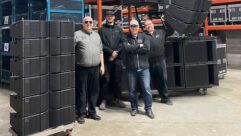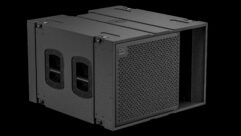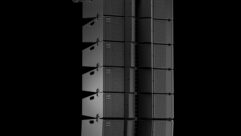
Installation Profile: Intelligent Design
Feb 1, 2009 12:00 PM,
By Jack Kontney
How technology helps realize a thoroughly modern vision for the new home of one of our nation’s oldest museums.

One of the California Academy of Sciences’ technology-intensive attractions is its Water Planet exhibit. The show plays from 7thSense Delta media servers to 10 ceiling-mounted projectiondesign F20 projectors. The show is projected to 10 edge-blended screens that are made up of a series of wave-shaped fiberglass walls that are embedded with fish tanks.
Photo: Tim Griffith
Founded in 1853, the California Academy of Sciences (CAS) is one of the cultural jewels of the San Francisco area. It houses an aquarium, a natural history museum, and a planetarium, all under a 2.5-acre living roof — a roof covered with 1.7 million plants and wildflowers native to the area — in its new building in Golden Gate Park. The academy is also a cutting-edge research and education facility, which is also housed in a new $500 million building designed by famed Italian architect Renzo Piano. The impetus for rebuilding the academy was the damage that the academy’s original building sustained in the Loma Prieta earthquake on Oct. 17, 1989.
In keeping with the academy’s self-imposed green mandate, the building features a wide array of eco-friendly design assets, making it the largest public building to earn the top platinum rating for Leadership in Energy and Environmental Design (LEED) from the U.S. Green Building Council. Through a design that combines water efficiency, solar energy, natural light, ventilation, and other features, the new academy will use about 35 percent less energy compared to a typical building of its size.
While the building is drawing praise from architecture and ecology observers, the design and construction of the three museums within the academy and their AV infrastructure was every bit as daunting and impressive. The primary audiovisual design firm involved was Oakland, Calif.-based Teecom Design Group, which brought BBI Engineering of San Francisco on board as the primary integrator.

The rainforest environment spans four levels via a curving walkway. A field-recorded soundtrack by famed bio-acoustician Bernie Krause of Wild Sanctuary is played back through a dozen Tannoy Di5t loudspeakers on each level.
Photo: Tim Griffith
“This was such a large project that we had a number of contracts within the academy, working with several outstanding design firms,” says Mark Roos, BBI vice president of engineering and the project lead. “So we acted as kind of a unifying force for many areas.” Among the other design firms involved were Visual Acuity in San Franciso, Cinnabar in Los Angeles, New Magic in Los Angeles, and Thinc Design in New York.
In terms of AV systems, various technologies cover a wide range of applications, from surround sound and blended multiple-projector videos to interactive exhibit experiences and comprehensive networking with local control. Such was the scale of the project that two additional project managers were assigned.
“At BBI, there is a company principal in charge on every project, plus one or more project managers, each responsible for different areas,” Roos says. In this case, there were two: Lisa Dunmeyer, primarily managing the first-floor exhibit areas, and David Kaufman, who handled the basement-level exhibits and AV system infrastructure.
Installation Profile: Intelligent Design
Feb 1, 2009 12:00 PM,
By Jack Kontney
How technology helps realize a thoroughly modern vision for the new home of one of our nation’s oldest museums.

Among the challenges of the installation was meeting the Americans with Disabilities Act mandate that all video systems have captioning available. The Cycling ’74 Max/MSP/Jitter graphical programming system allows captioning to appear in less than half a second.
AV INFRA-STRUCTURE
The system starts with the AMX Resource Management Suite (RMS) — which allows scheduling, administration, and tracking of devices across the academy — augmented by a Peavey Electronics MediaMatrix Nion system for networkable DSP control of audio.
“We’ve been doing MediaMatrix for years and have used the Nion product since it came out,” Roos says. “It has great scalability because it has a high-speed bus that allows you to connect a lot of processors together.” In essence, this gives the museum a from-anywhere-to-anywhere routing capability, making it ideal for everything from custom presentations to standard PA announcements. This server system also monitors the equipment at each of the roughly 300 IP addresses scattered around the building.
“It’s a bit complicated, but the cool thing is that it’s easy and seamless on the surface,” says Sasha Harris-Cronin, lead programmer on the project. “The AMX system talks to the RMS, which talks to the SQL database, which talks to a Flash application we developed. In the Flash app, we have equipment icons and a map of the actual museum, so they can easily view the status of every device.”
Another custom application developed by BBI was an interface that allows academy personnel to control the volume of individual exhibits via an Apple iPhone and iPod Touch.
“Basically, we use them as web browsers,” Harris-Cronin says. “They connect to the AMX system, which knows where all the exhibits are. When museum staff navigates to the location on their iPhone, they can access volume up/down and mute controls. It’s very easy to use.”
Another nice touch developed by BBI is the fact that all the exhibit computers turn off at night to conserve power.
“That’s unusual in a museum,” she says. “To do it, we created a little server that runs on each computer. The AMX system tells the computers to go to sleep at night and then wakes them in the morning using the Wake-On-LAN feature.”
Wayfinding signage is located near the front entrance. Two groups of three 52in. NEC MultiSync LCD5220 monitors display information about museum events and provide welcome signage for after-hours private events. Planar Systems CoolSign software provides content-creation and management tools.
INTERACTIVE EXHIBITS
The academy’s first floor includes two large flexible exhibit areas, covering subjects as diverse as climate change, evolution in the Galapagos Islands and Madagascar, the Northern California coast, and Philippine coral reefs. Historic Africa Hall includes a series of dioramas and a live penguin exhibit. The main halls are dominated by two huge globes, one housing the planetarium and the other a rainforest environment.
Most of the individual exhibits are local, typically including video content triggered by a motion sensor. The two main challenges were creating an audio environment that was intelligible without interfering with neighboring exhibits and compliance with the Americans with Disabilities Act (ADA).
For audio, BBI developed a proprietary system of miniature line arrays. The loudspeaker arrays are custom-made for BBI by Innovox Audio, which specializes in high-fidelity, low-profile audio solutions. The system consists of eight loudspeakers using either 2in. or 3.5in. drivers and driven by BBI’s proprietary LAAMP8, an 8-channel DSP amplifier with vertical dispersion adjustment when mounted horizontally.
Installation Profile: Intelligent Design
Feb 1, 2009 12:00 PM,
By Jack Kontney
How technology helps realize a thoroughly modern vision for the new home of one of our nation’s oldest museums.

In the Water Planet area, there are several interactive exhibits called Imagers. Visitors interact with the exhibit by waving a hand over parts of the tabletop surface. The shadow of the hand wipes away the image to reveal new content.
“This is a very open, reflective space, with about a dozen or so exhibits in fairly close proximity in each of the main areas on the first floor,” Dunmeyer says. “Having the ability to focus audio in a very specific path really helps. So when you move from one display to another, you move out of the beam of one speaker system and into the next.”
The tabletop displays have room for wheelchair access, which in turn created a need for small computers and compact rear-projection systems that are designed for extremely short throw. For this reason, the most challenging exhibits contain a Mac Mini computer and Toshiba TDP-EW25U video projector.
The museum’s ADA mandate dictated that all video systems have captioning available. With both HD and SD displays, finding a seamless method for providing captioning was a challenge. The solution was to create an application suited to the task.
“We just couldn’t find a playback device that could switch to captioning on the fly in an attractive and timely manner. You don’t want to wait multiple seconds; it should just be like a reveal,” Harris-Cronin says. “We used a graphical programming environment by Cycling ’74 called Max/MSP/Jitter. Basically, you push a button for captioning, and the computer just jumps to a different piece of video in the same spot, but with captions in place. It takes less than half a second.”
Exhibits called Person-Facilitated Experiences (PFE) put a human face on things. Basically, these allow visitors to interact with working personnel, mediated by a docent. Examples include a dive show in the coral reef exhibit, penguin-feeding shows in the Africa Hall, and a working research station.
The Philippines Coral Reef is a two-story tank containing live coral and hundreds of various fish. Periodically, a diver enters the tank and speaks with observers through a Clear-Com CellCom intercom system.
“With one Cell 10 station, you can get six completely different audio pathways, so we could do all the exhibits we needed with a single system,” Kaufman says. For underwater applications, the diver wears a full face mask with integral microphone and headphones from Ocean Technology Systems; a comm line carries audio up to the surface where the CellCom beltpack resides in a waterproof case.
The popular African Penguin exhibit also features a live show, with penguin cams, which are also viewable on the museum’s website. The cameras are Sony SSC-DC374s, each encased in custom weatherproof housing to prevent degradation from the salt, humidity, and smells of this living exhibit.
Another unique exhibit is the Research Lab. The academy has a long history of leadership in field research, and it wanted to make it more accessible to the public. A glass wall allows guests to see the researchers, who can present content from their ongoing projects. A projectiondesign F10 1080p projector accepts images from a microscope camera, a DNA sequencer, a ceiling-mounted videocamera, or a video source. Again, the researcher uses a CellCom 10 system to communicate via loudspeakers on nearby kiosks, while the docent uses a handheld Sennheiser ew335G2 wireless system to relay questions and comments. Both the Clear-Com system and the Sennheiser wireless are used throughout the academy and routed through the MediaMatrix system.
“It’s kind of a complicated audio path,” Kaufman says. “But again, if desired, we can take those signals and output them anywhere in the building. Once the signal is in MediaMatrix, you can do just about anything with it.”
Installation Profile: Intelligent Design
Feb 1, 2009 12:00 PM,
By Jack Kontney
How technology helps realize a thoroughly modern vision for the new home of one of our nation’s oldest museums.
Sennheiser was chosen for its reliability and user-friendliness. “Golden Gate Park is a notoriously crowded RF environment, and we made a decision to recommend Sennheiser wireless throughout the museum based on the number of simultaneous channels they could support. That’s a project standard,” Roos says.
WATER PLANET
Downstairs is the aquarium, where the largest attraction is the Water Planet show — a 10-screen, edge-blended display running on Delta media servers from United Kingdom-based 7thSense and viewed via 10 ceiling-mounted projectiondesign F20 video/data projectors. To complicate matters, the show is viewed on a series of four wave-shaped fiberglass walls that are embedded with fish tanks.
The show runs every 30 minutes and is controlled by BBI’s proprietary MSC-4MP3 show controller — which handles timing, room lighting, and audio in addition to triggering the projection system. Then it returns the room to its normal ambient condition between shows. Program audio is an 8-channel immersive system using Meyer Sound UPM-1P self-powered loudspeakers and UMS-1P subwoofers.
Precise control of lights and projectors was critical because deep-water fish living inside the tanks could be adversely affected by the show. Masks to prevent projections from shining into the tank were created on the 7thSense Delta media servers. Between shows, the projectors are used for exhibit annotation and wall washes. The digital ID signs next to each fish tank are also dimmed during shows and returned to normal afterward.
The Water Planet area also houses several interactive exhibits called Imagers. Visitors interact with the exhibit by waving a hand over parts of the tabletop surface. The shadow of the hand wipes away the image to reveal new content. To create this scenario, BBI lit the exhibits with infrared, and then the company added an infrared filter to an overhead camera. The camera feeds are analyzed by vision software developed by BBI that communicates to Adobe Flash software. The resulting content is displayed on the exhibit from projectiondesign F10 projectors.
Another attraction is a series of radio-frequency identification (RFID)-based interactive exhibits called Divestations. For these, actual museum specimens were encased in acrylic tubes. When placed into appropriately sized indentations on the display surface, the embedded RFID tag triggers new content that is specific to the exhibit theme and specimen in Flash using ASPX’s RW-210 RFID readers.
THE AUDITORIUM
For AV fanatics, one of the big attractions is the auditorium, a large room that is split into two spaces. The east room houses a 3D movie experience with seating for about 200. The cinema video projector is a Barco DP-2000 3D projector equipped for Dolby 3D Digital Cinema by Bay Area Cinema Products. The projector shoots onto a retractable Stewart Filmscreen Model B Electriscreen that is ceiling-mounted in front of the dividing wall. And yes, viewers of the 3D show get to wear those cool filtered glasses. For more standard presentation programming, digital sources — including computers and a Denon DVD-2500 Blu-ray player — are played through a digitalprojection Titan 1080p-600M projector.
Surround sound for theater mode is provided from the Dolby Show Player as AES/EBU and from the Blu-ray player via a Denon DN-A7100 decoder. Both are routed via a MediaMatrix Nion to a Meyer Sound system. Front left and right loudspeakers are the UPQ-1Ps, a wide-coverage design with full-range response, mounted high on the sidewalls. The center dialogue loudspeaker is a UPJ-1P mounted in the ceiling above the screen. All surround loudspeakers are Meyer Sound UPJuniors, with four each mounted on the left, right, and rear walls. Low frequencies are provided through two Meyer Sound 750-P subwoofers.
In the west room, a second Stewart Filmscreen Model B Electiscreen is located on the far wall, flanked by another pair of Meyer Sound UPQ-1Ps. Presentations are delivered via another Titan 1080p-600M projector, and a Sony BDP-S500 Blu-ray DVD player is available. In full-room configuration, the center wall slides away and its screen retracts. In this mode, the UPQ-1Ps (left-right in the 3D theater mode) become delay loudspeakers for the back half of the auditorium.
Installation Profile: Intelligent Design
Feb 1, 2009 12:00 PM,
By Jack Kontney
How technology helps realize a thoroughly modern vision for the new home of one of our nation’s oldest museums.
EVEN MORE STUFF
The range of systems and technologies used at the California Academy of Sciences is simply staggering. The rainforest environment spans four levels, from underwater Amazon River views in the basement up to the canopy (covering four different rainforests), via a curving walkway. The space is filled with the sounds of a field-recorded soundtrack by famed bio-acoustician Bernie Krause of Wild Sanctuary. The soundtrack is played through a dozen Tannoy Di5t loudspeakers on each level, with each loudspeaker group receiving its audio mix from a BBI MSC-4MP3 show controller to allow randomization and realtime fades. Playback is triggered by sensors.
In the very center of the academy’s first floor is the piazza, which is essentially an all-glass multipurpose room. Audio comes via a Meyer Sound MVC-5 graduated vertical coverage fixed array.
“While it was important to get quality audio into every public space, it was equally critical to maintain the architect’s vision,” Roos says.
In the piazza, that meant custom paint and special mounting for the loudspeakers. In other areas, it meant eliminating touchpanel wall controls. Balancing the conceptual vision of the designers in a seamless, yet highly functional way that appeals to both academy staff and visitors is exactly the sort of challenge that BBI Engineering craves.
“The California Academy of Sciences is a cultural landmark in San Francisco. In the museum business, the stakes are high. You have to open on time, and everything has to work,” Roos says. “We like to think we’re the kind of company that can rise to that kind of challenge. If there’s no space for a touchpanel on the wall, we can put it in your pocket. This was a great project because it gives us an opportunity to show our creativity as well as our technical chops. At the end, you really know you’ve accomplished something.”
Jack Kontney is contributing editor, audio for SVC and president of Kontney Communications, a content-creation, marketing, and PR firm specializing in professional audio, video, and electronics. He can be contacted at [email protected].










